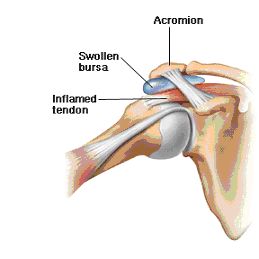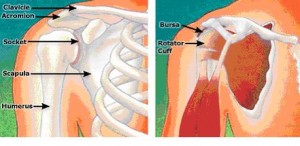Anatomy – There is a small space (subacromial) between the head of the upper arm bone (humerus) and the acromion (a bony projection from the top of the shoulder blade) that the rotator cuff passes through.
Raising the arm overhead normally causes the head of the humerus to raise upwards slightly within the subacromial space. This naturally will narrow the space between the head of the humerus and the acromion causing compression of the rotator cuff tendons and bursa. As we age, the blood supply to the rotator cuff diminishes making the rotator cuff more susceptible to injury/damage. If the rotator cuff or bursa becomes inflamed with repetitive compression the subacromial space becomes even smaller with overhead movements of the arm thus causing more compression. This may lead to impingement syndrome.

Bursitis (inflammation of a bursa) often occurs along with tendonitis and/or impingement syndrome.A bursa is a sac (containing a small amount of fluid) located between the tendon and bone that helps the moving parts of a joint glide smoothly. There is a bursa between the supraspinatus (a rotator cuff tendon) and acromion (roof of shoulder blade).
Occasionally, calcium deposits or bone spurs may be present within the rotator cuff tendon(s) or the underside of the acromion. This can also cause impingement syndrome.
Activities (such as swimming, tennis, painting overhead, etc.) that involve repetitive overhead arm movement can cause repeated contact and friction between the rotator cuff tendons and the undersurface of the acromion.
Symptoms of Shoulder Impingement
Symptoms usually start gradually in the top-outer portion of the shoulder. There may be mild pain all the time, with sudden pain when reaching overhead and pain when lowering the arm from an overhead position. There may be weakness of the shoulder. If not treated, the condition may worsen.
Treatment of Shoulder Impingement
Strengthening the rotator cuff (especially the supraspinatus) and the shoulder blade muscles helps prevent the humerus from rising excessively with overhead movement of the arm. Proper posture of the shoulder at rest and with activity is very important as “slouching” can narrow the subacromial space; resulting in more impingement.
Stiffness of the shoulder joint capsule is common in impingement syndrome which responds very well to manual stretching. Ultrasound (sound wave therapy) can help to increase circulation to the tendons and help reduce swelling. Taping techniques are also beneficial in helping to center the humeral head within the socket which may diminish the impingement of the rotator cuff tendons.
What Should You Do?
If your pain has been persisting for several months you should see you family physician for an assessment and he/she will order any diagnostic tests (x-rays, ultrasound) if appropriate. You should see a physiotherapist as soon as possible to determine the proper course of active treatment that is best for you. Your physiotherapist will be able to give you home exercises (stretches and strengthening exercises) that are right for you and he/she may also manually stretch your shoulder to restore mobility to the joint.
Please feel free to send me an email if you have any further questions!


